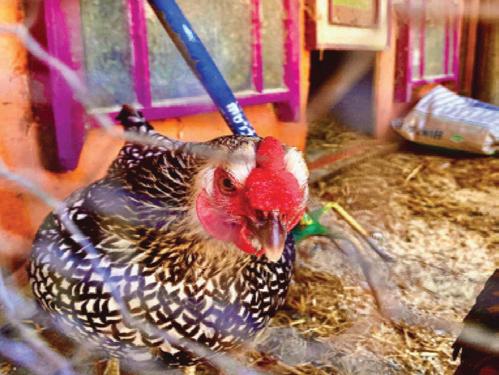

Special Science Edition



ICE raids take toll on economic status, emotional health
By Emma Rocha ’25
Recently, Immigration and Customs Enforcement (ICE) raids are targeting undocumented workers. These raids have created a lot of worry for communities in regards to immigrant labor and emotional stress for families in terms of the future.
Industries such as construction, farming or agriculture are now facing possible labor shortages, wondering what economic consequences might happen long term if these mass deportations keep happening.
“It makes me very angry, it makes me very sad, and very disappointed in the country that I love, the United States,” said Armando Castillo, moderator of Latinos Unidos at Archbishop Riordan High School.
Undocumented workers play a vital role in sustaining industries who struggle to fill positions that U.S citizens tend to not want to do.
According to The Fulcrum, states like California, Texas, and Arizona consider immigrant labor a “necessity” due to many labor shortages.
The writer of this article, Steven Hill, stated “nearly 2.8 million immigrants account for more than 18 percent of the industry’s force.”
The removal of these workers could shrink the U.S. workforce and affect daily living, driving up costs, and consumer prices.
Castillo, who is also a Spanish teacher and a U.S. Marine Corps. veteran, said labor shortages will affect the country.
“The price of fruits and vegetables is going to skyrocket because of the scarcity of the products due to the interruption of a dispersed labor force.”
For example, many immigrants work in the fields harvesting crops for hours in the sun. This job is one that if unoccupied by its current workers will become very difficult to fill. Without enough workers to harvest crops, food waste will increase, causing loss for farmers and suppliers who heavily rely on immigrant workers.
Additionally, the field of construction could also become impacted as projects can be delayed due to lack in skilled laborers.
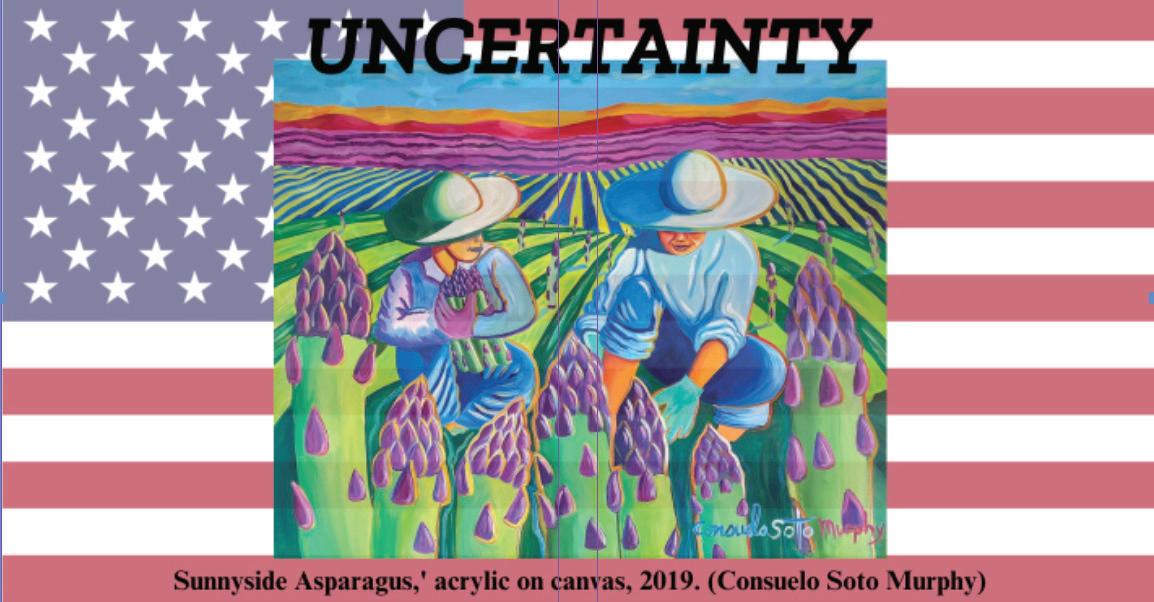
The recent ICE raids on farmlands and factories have created economic uncertainty for migrants, leading to mental health concerns for them.
“There are millions of acres of oranges, asparagus, apricots and every other kind of crop in the United States that are lying in the field with no one to pick them.”
“They destroyed their workforce and they cannot find replacements because Americans will not do that kind of work, for that kind of pay, for those kind of conditions,” Castillo expressed.
In regards to possible economic consequences, immigrant families contribute greatly to their local economies. Housing, transportation, and outside purchases are all contributions that every family has to make and the absence of immigrants will lead to reduced economic status as a whole. For tax revenues as well, undocumented

immigrants still contributed billions of dollars not qualifying for any government aid.
Removing workers from places that need them to support their businesses will affect more than just one person. It affects the economy and the wellbeing of numerous families and communities.
The social consequences of ICE raids are not just affecting statistics for economies. Families are being separated, leaving U.S. born children without parents and communities without key members. Emotional trauma is also expected to play a role specifically for the younger generations being directly hit by these separations.
Anxiety, depression, public health conditions, and homelessness are all potential factors following the ICE raid repercussions and are primary reasons why communities are choosing to protest.
“I saw many people our age in their teens fighting for their parents who are immigrants and who are fighting for not just them, but for many others who are truly

working and just want to start a new life to help their families,” said Israel Covarrubias ’25.
According to the U.S. Committee for Refugees and Immigrants, “Laws and policies aimed at increasing police and immigration surveillance and enforcement result in decreased mobility for undocumented immigrants, disruptions in employment opportunities and social support relationships, and limited access to public services, as well as chronic fear, anxiety, and stress surrounding deportation, detention, and family separation.”

Photo from Latinos Unidos Instagram
Graphic by Emma Rocha ’25
Photo from Latinos Unidos Instagram
People gather at San Francisco City Hall, protesting recent ICE raids.
Scan the QR Code to watch a video story related to this article.
2 Science
Archbishop Riordan High School
ICE raids take toll on economic status, emotional health
Continued from page 1
In addition, the raids are “directly associated with adverse mental health outcomes among undocumented immigrants, including increased rates of depression, anxiety, post traumatic stress disorder (PTSD), and substance use.
Of particular concern is the children. A study by Boston University concluded that children of undocumented people “are more at risk of psychological distress and mental health issues due to trauma and fear for their parents.”
Also, “these learning and situational risk factors, environmental risk factors, and biological risk factors can affect a person’s life, especially in the case of children who now have to grow up with the trauma of their parents being deported and possibly being forced into adoption centers or with a family member with legal status (possibly family members who they have never met or might not trust).”
The U.S. Department of Homeland Security offers links
to Temporary Protected Status, Asylum in the U.S., InterCountry Adoptions, and Refugee Resettlement to the U.S., but nothing specifically about aiding those suffering from mental health conditions as a result of being detained or deported by ICE.
The Department of Health and Human Services reported in “Healthy Border 2030” that “Migrants and locals in these areas (states that share a border with Mexico) face compounded stress from both climate events and pre-existing economic struggles, necessitating increased mental health interventions.”
It also acknowledged “Legal uncertainties surrounding the status of migrants may deter them from seeking timely medical assistance, creating a public health challenge.”
With the economic, social and overall health of those directly and indirectly affected, organizers in cities like Los Angeles and San Francisco seem determined to persist with rallies in support of
Mission Statement for the Archbishop Riordan High School Newspaper
The mission of The Crusader is to inform, educate and entertain the readers—students, teachers, parents, members of the community—about issues that affect the students as well as citizens of San Francisco and the nation. We hope to instill a sense of understanding, responsibility, and curiosity in our readers that results in an eagerness to learn more about their peers and the world around them.


175 Frida Kahlo Way San Francisco, CA 94112
RCrusaderNews.com
RCrusaderNews@riordanhs.org
Editor-in-Chief
Angela Jia ’25
Managing Editor
Aiden Pavon ’25
Opinion Editor
Hoorain Farooq ’25
Campus News Editors
Katelyn Leong ’25
Ashley Villing ’25
Local & State News Editor
Isabelle Abad ’26
National & World News Editor
Daniella Lainez ’26
Boys Sports Editor
Ishaan Gupta ’26
Girls Sports Editor
Eva Bennett ’25
Sports Features Editor
Liam O’Connor ’25
Arts & Entertainment Editor
Hailey Ferrer ’26
Environment Editor
Helena Kai Murguz ’25
Religion Editor
Vincent Douglas ’25
Health Editor
Catherine Hansen ’25
Science Editor
Griffin Doeff ’25
Business & Technology Editor
Caitlin Dowd ’25
Features Editor
Hazel Nagata-Rampata ’26
Food Review Editor
Loghan Hwang ’27
Senior Photo Editor
Sean Reyes ’25
Photo Editors
Ethan Ly ’26
Julia Yamsuan ’25
Copy Editor
Rose Baik ’26
Graphic Artists
Vee Chen ’25 and Kai Murguz ’25

immigrants. Covarrubias said, “It’s just monumental to see how many people do care about their
community and how they care about the future of not just individual places but this country as a whole.”

Reporters and Photographers
Aarav Agrawal ’28
Julian Amann ’26
Josephine Andre ’27
Robert Bennett ’27
Keira Cabuntala ’27
Alejandro Coriano ’26
Nicole Diaz ’26
Gregory Florseca ’27
Isabel Fonseca ’27
Mark Gabancho ’26
Rachel Gerke ’27
Vanessa Gonzaga ’27
Ashling Greene ’26
Riley Guajardo ’26
Grace Hoelsken ’25
Luca Hrvatin ’25
Malcolm Jones-Smith ’25
Lorelai Keating-Curran ’27
Genevieve Kohlmeyer ’25
Ethan Krasner ’26
Exchange Editors
Marley Naniola ’25
Taylor Tran ’25
Reporters and Photographers
Daniela Krasnoshchok ’26
Alessandra Leon ’26
Ciarra Mangibuyat ’27
James McDonell ’27
Julia O’Neill ’26
Ariana Ortiz ’26
Kianna Panaligan ’27
Erin Quan ’26
Andres Roca ’25
Emma Rocha ’25
Isaiah Sanchez ’26
Giana Tocchini ’26
Keira Wallace ’26
Zoe Walker ’28
Elizabeth Walsh ’26
Crystal Wei ’26
Miles Witte ’27
Marvin Wong ’25
Charlottie Yip ’26
Adviser
Susan Sutton, MJE
Letters to the Editor
Letters to the editors will be accepted with the same deadlines as ads. These letters may come from students, staff, parents, board members, or other members of the community. The Crusader reserves the right to edit the letter for grammatical and spelling errors, as well as length, but not content unless it includes foul language, plagiarized material, or libelous content. If the claims or assertions are incorrect, The Crusader reserves the right to refuse publication of the letter.
Photo from Latinos Unidos Instagram
As ICE raids have increased in cities like Los Angeles and San Francisco, so have the protests against the actions and in support of immigrants.
Research finds bacteria on paper money
By Vincent Douglas ’25
Money is, simply put, filthy. It is passed around from restaurants to gas stations to farmer’s markets to baseball stadiums. Despite this, very few people ever think about how dirty money actually is.
According to NPR, the most common bacteria found on U.S. currency are those that cause acne, diphtheria, and anthrax. There are also bacteria found from the mouth and genitals on money.
Edgar Franco ’25 runs an independent barber business in which he takes great care in maintaining a sanitary environment.
“I have a spray which is a disinfectant for all the metal clippers, and I have barbicide which cleans the combs, the brushes, and I wash my capes every week,” said Franco.
“I think it’s probably a good idea that we’re moving towards more of a digital currency for many reasons, one of which being paper money can act as a vector for certain diseases, bacteria being the major culprit.
-Brian Tuel, Biology teacher
Despite this, he said that germs on money is not a concern of his since he washes his hands regularly.
Biology instructor Brian Tuel said, “I think it’s probably a good idea that we’re moving towards more of a digital currency for many reasons, one of which being paper money can act as a vector for certain diseases, bacteria being the major culprit.”
Few people are actually aware of how many germs are in their pockets.
Chloe Hui ’25 estimated that 200 different types of bacteria can exist on a dollar bill. The article by NPR places that number closer to 3,000.
It is not just bacteria that can be found within money. There have been multiple studies which found traces of cocaine on a large number of dollar bills.
In 2018, Dickson College reported that nearly 90 percent of bills in circulation have “cocaine residue.” While harmless, it is

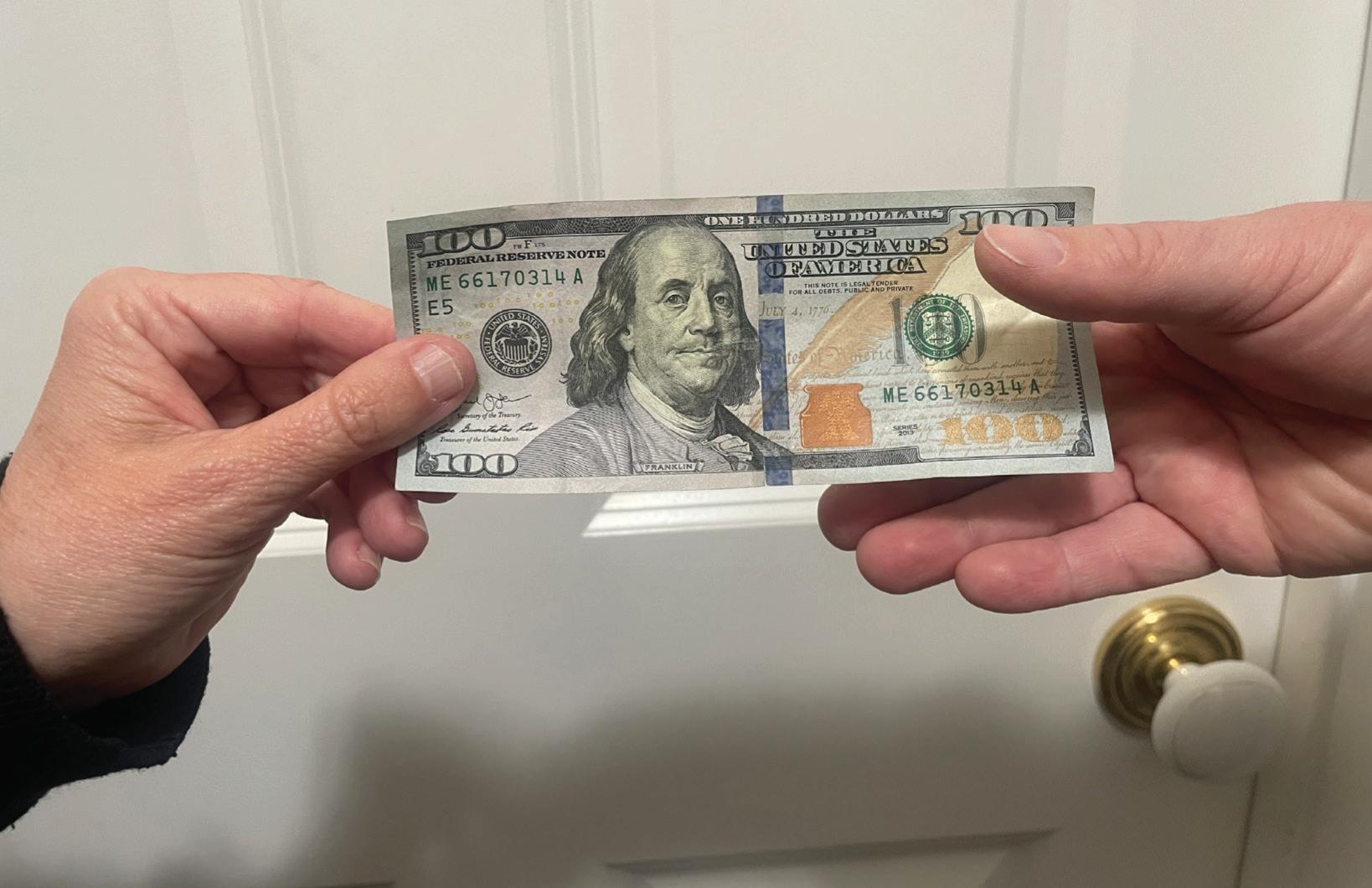
Despite being the cornerstone of modern society, many people do not often put thought into how much bacteria is found on their paper money. Bills can be handled by over a hundred people before it is sent to a bank to be cleaned.

For a podcast about money at baseball games with former hot dog vendor Michael Vezzali-Pascual ’88, scan the QR code.
notable that the substance can still be found in the pockets of a person who had no relation to it.
Hui added, “My parents always told me to wash my hands after dealing with money, not to touch my face or eat food with my hands after dealing with money.”
At the same time, people are very conscious about germs in general. It has now been five years since the COVID-19 lockdowns, and the general attitude towards sickness has changed over that time.
It is now commonplace to see hand sanitizer bottles on desks and around stores and workplaces.
Tuel mentioned that the past winter flu seasons have seen many students and teachers get sick, but he also noted that people are now more likely to stay home when sick.
Tuel described a dollar bill as “a reservoir of E. coli, one bacteria that can be harmful if it’s found in large amounts.”
“My parents always told me to wash my hands after dealing with money, not to touch my face or eat food with my hands after dealing with money.
-Chloe Hui ’25
However, just because money is dirty does not mean that it has lost its value. Banks have special techniques for handling dirty money. If it is a biohazard, it is doubled sealed in plastic bags and sent for special cleaning.
The Federal Reserve Bank of Boston reported receiving money damaged by mold, water, and

even blood.
Some are more concerned about germs on dollar bills than others, and with good reason.
Bills are not cleaned unless specifically requested by a bank, so bacteria can linger on it for long periods of time.
However, it may be comforting to know that the paper material holds most bacteria, so it is unlikely that it will rub off on skin or clothing.

For a video about bacteria found on paper money and the transition to digital transactions, scan the QR code.
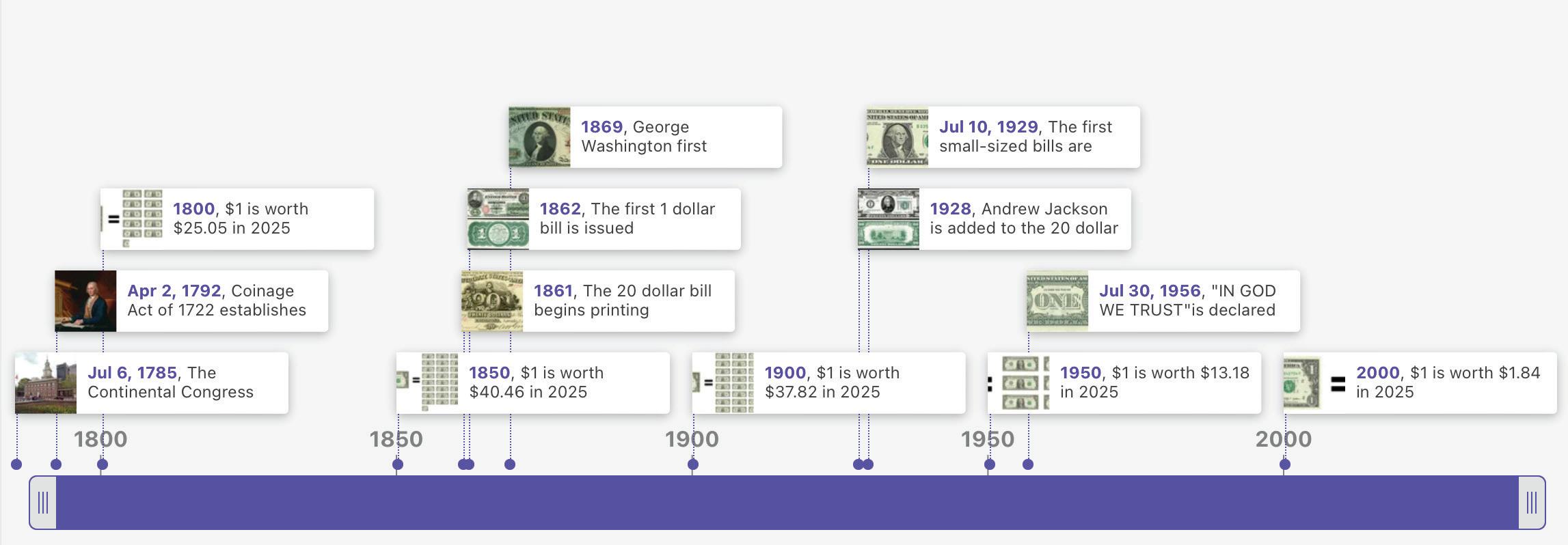

Photo by Vincent Douglas ’25
For a theoretical map of how money can transfer throughout San Francisco, scan the QR code above.
This timeline shows the evolution of the modern US dollar. For the full timeline, scan the QR code in the right corner.
Timeline by Vincent Douglas ’25
4 Science
California’s bird flu outbreak spreads its wings
By Julian Amann ’26
Since the first outbreak of the virus in 2022, the bird flu (H5N1) has spread across the United States.
In California, the virus is sending a warning not only for the farmers, but for the public and residents.
Colleen O’Rourke, Riordan biology teacher and a 4H member, said, “H5N1 is a strain of the virus influenza, which causes a series of symptoms in humans and other animals which we often label as ‘the flu’.”
Different strains of influenza specialize in infecting specific types of animals, but some strains of influenza mutate enough to be able to “jump ship” and infect other types of animals.
“I’ve read a hypothesis that in fact all strains of influenza–which is the specific type of virus that causes the actual ‘flu’–originally came from birds and started crossing over into human populations thousands of years ago,” O’Rourke said.
With several birds already dead and the flu is spreading to animals like cows and human beings, scientists worry this could grow into a more serious health problem for others if not maintained.
“H5N1 is a strain of avian influenza, meaning it’s most commonly found in birds, but recent evidence indicates that it is mutating enough to infect mammals like cows, cats, and humans,” O’Rourke explained.
H5N1 has spread throughout wild birds. In the state of California, farms have been affected more than others, with several birds like chickens, ducks, and turkeys affected since

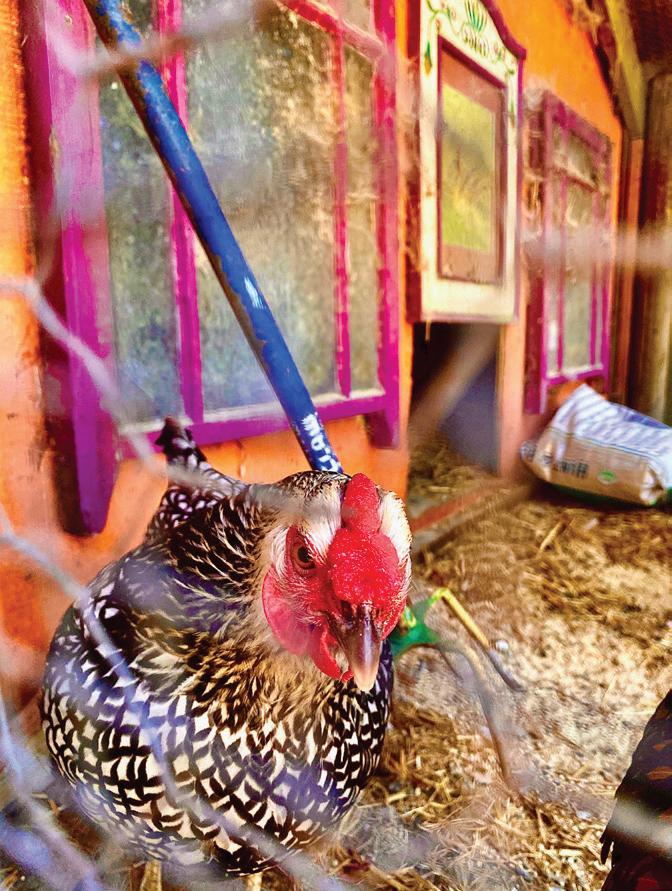
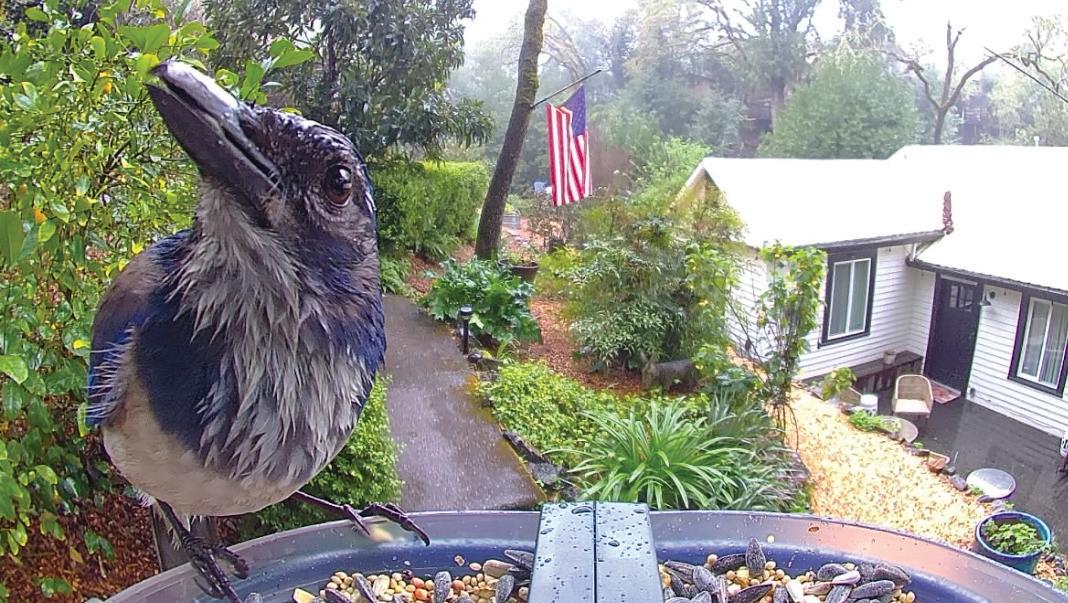
by Julian Amann ’26
Many birds gather in rural, urban and suburban areas, and wildlife experts have reported a H5N1 surge within various wild birds. The virus is spreading fast through bird populations and experts warn it could spread to humans.
the virus started in 2022.
The virus not only has stopped at the birds but according to the USDA, it has spread to thousands of dairy farms across 17 different states of the country.
O’Rourke said, “Birds are extremely susceptible to respiratory infections even under the best circumstances, so when a respiratory-specific virus enters an agricultural poultry flock–where many birds are kept in smaller areas together – it can spread like wildfire.”
Vet doctors from UC Davis School are analyzing the spread, watching the movement very closely. Studies show that the spread towards cattle is concerning.
The virus started spreading into food, tools, and through animals. Once the cattle get sick, milk supply usually plummets
and the cows have a loss of appetite and they get fevers. Some cows that might not die from the flu will be weak for a long period of time, affecting the animal and the price of the cattle.
While most are fixated on the animals being harmed by the virus, humans have also been getting infected as several cases have been reported in California.
“Apparently yes, there have been a couple documented instances of humans becoming sick with H5N1, including a few deaths. It is still uncertain whether there was human-to-human transmission in these cases, though, but it’s still an important reminder to take biosecurity seriously in our lives,” O’Rourke explained.
Between September and December 2024, around 40 people were tested for the virus or
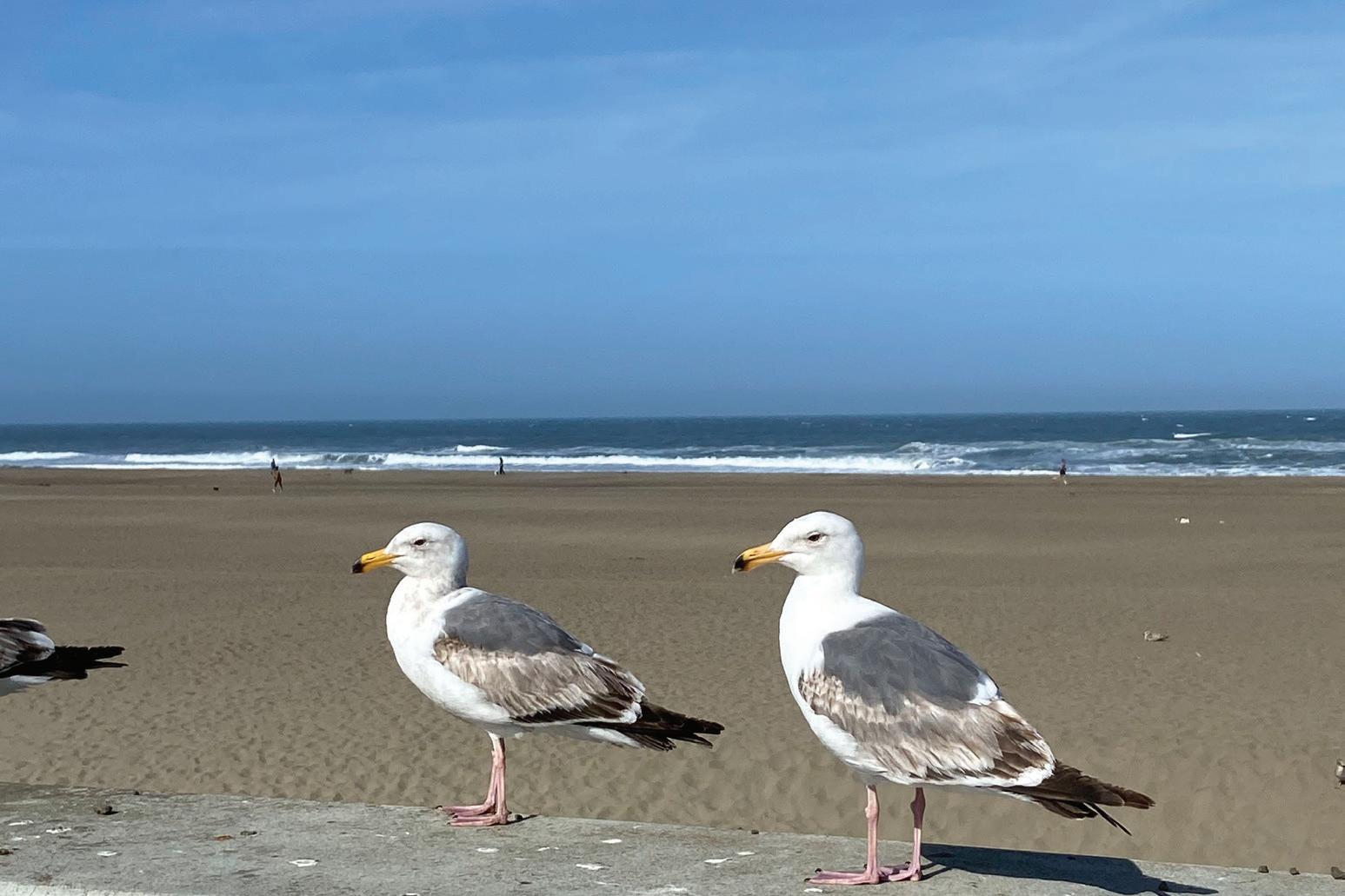
H5N1 and all ended up being positive. Some of those people were farmers and some were regular citizens living in California. One of the cases had a child who was near the virus but wasn’t infected.
Being able to go from human to another human with this virus is rare. The Centers for Disease Control and Prevention (CDC) is also watching the spread of the virus.
“Anytime a virus jumps species, we watch for mutations that could make it easier to spread,” the CDC explained in a recent report.
“We are concerned about potential future risks, especially if the virus becomes more transmissible among people.”
Health experts want others to work their farms with protective material to stop the risk of any humans being infected.
The economy of California has been affected by the H5N1 virus and is already impacting many people living near these infected areas. Various farms have isolated birds to stop the spread, causing economic issues.
Dairy farms are also challenged by setbacks. The CDFA (California Department of Food and Agriculture) has teamed with the USDA and farms to stop the virus and give support. Veterinarians are also at stake. Many doctors are doing their best to protect farms, but also work with small amounts of information.
The UC Davis School of Veterinary Medicine will continue to update the public on risk of being infected as research continues.

Birds are extremely susceptible to respiratory infections even under the best circumstances, so when a respiratory-specific virus enters an agricultural poultry flock it can spread like wildfire.
-Colleen O’Rourke, biology teacher
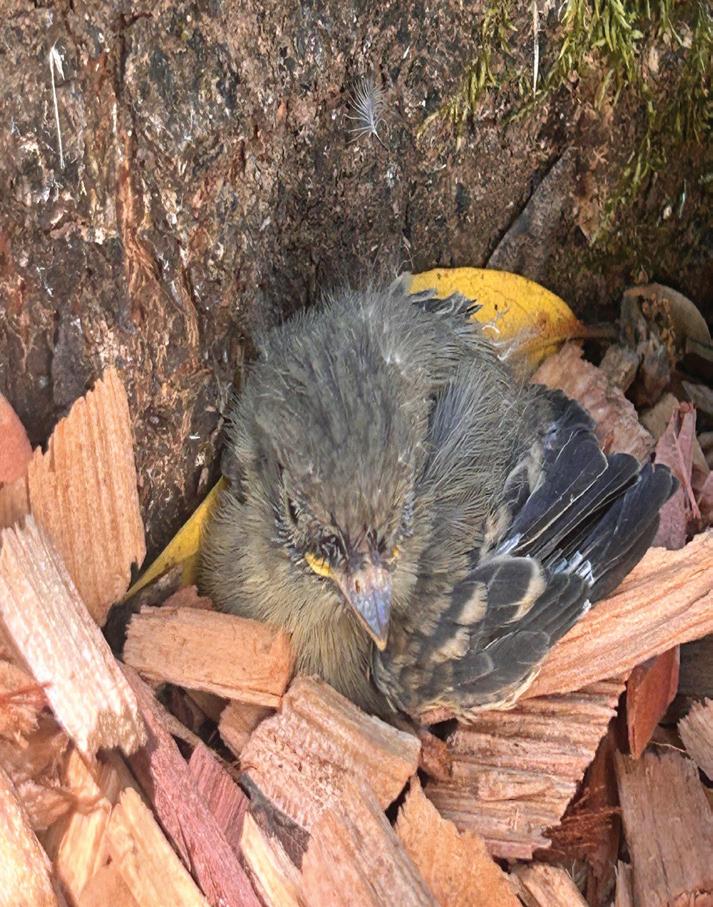
Photo
Scan this QR Code to enter a podcast with biology teacher and 4H member Colleen O’Rourke at 4H talking about the risks and spread of H5N1.
Scan this QR Code to enter a Zoom with Celeste Prothro, Infection Prevention Program Manager at Kaiser Permanente, talking about the human aspect of bird flu.
At left, a chicken sits behind a fenced coup in Northern California. Top, two seagulls take in the views at Ocean Beach. Right, a bird rests in its nest in a local neighborhood. Bird flu cases have risen across poultry organizations and wild birds in recent months, raising concerns that it may affect humans.
Photos by Julian Amann ’26
Hawks: BART’s newest strategy for pigeon control
By Aiden Pavon ’25
BART passengers may be surprised to see an unexpected set of wings when they get to their station. It’s not one of the many pigeons that show up uninvited, but instead, a Harris’s hawk named Pac-Man.
Pac-Man and his handler Ricky Ortiz come from an organization called Falcon Force. BART hired the company to help combat an excessive pigeon population at El Cerrito del Norte station, which has been extremely effective with handling the situation.
According to ABC7 News, Ortiz said, “Usually when the birds see me walking they already know, so they usually start to take off if there are any. And if not then I just let him go and he usually just flies from perch to perch, and I call him back, and that’s enough to get ‘em out of here.”
The company makes sure that no pigeons are harmed in this process. The presence of a predator only makes it difficult for the pigeons to live there, forcing them to move somewhere else.
According to NPR, the owner of Falcon Force, Vahe Alaverdian said, “So they just basically go across the street into the other parking lot and find the docks and so on to continue life ... without getting harmed.”
In a podcast with The Crusader,
Riordan science instructor Colleen O’Rourke said, “That’s literally what would be happening in the wild anyway.”
BART itself is impressed at the impact Pac-Man has had on the stations, which has prompted the transit company to expand their initiative across 12 more stations. Despite the reach of the initiative, people are usually unbothered by the presence of a hawk.
Riordan student Lucas Libiran ’26 said, “All the times that I’ve seen the hawks, they don’t really bother anyone and are with a human being at all times so I think I’d prefer to keep them rather than have pigeons everywhere.”
Interestingly, Pac-Man’s impact doesn’t stop there. He has become an icon, and they even turned the hawk into a mascot. He’s companions with an anime character named Nimbus, who was given the title “bard of BART.” Some Bay Area residents are conflicted in their feelings about the mascot.
Katelyn Leong ’25 said, “A big part of me is a little hesitant to get on board with this because it doesn’t really represent BART, just the aspect of pigeon population control, and I think it takes away from an iconic aspect of city life by smearing it with a trendy character.”
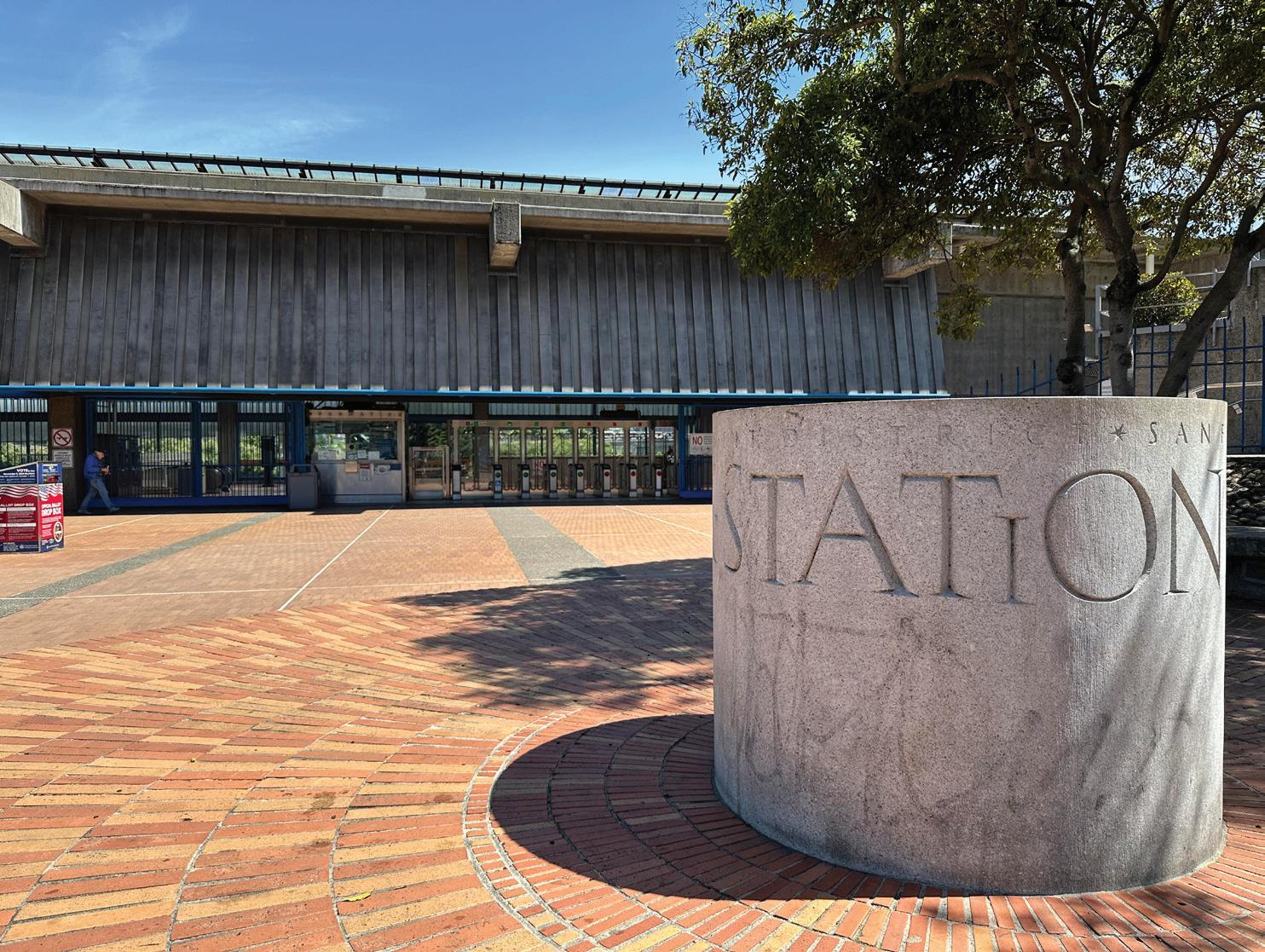


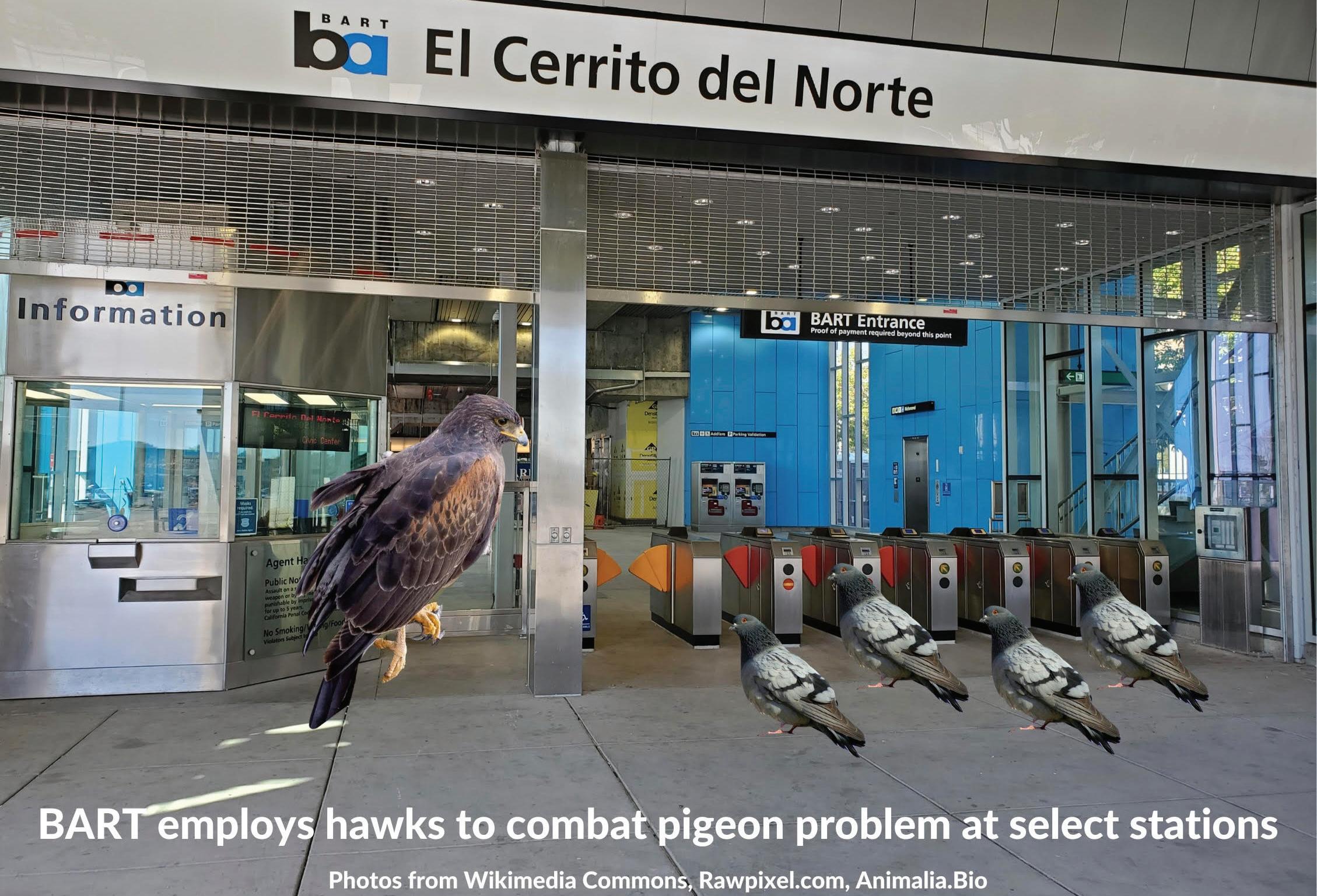
Photo by Aiden Pavon ’25
Glen Park Station is one of the BART stations with a high pigeon population.
Photo illustration by Aiden Pavon ’25
The falconeering strategy originated from El Cerrito del Norte Station. After the initial success, BART expanded the initiative to stations all over the Bay Area.
Watch a video following the pigeon population of San Francisco and the local opinions on them.
Join Aiden Pavon ’25 and biology teacher Colleen O’Rourke as they discuss the world of pigeons.
Science
Makeup with a mission
By Daniella Lainez ’26
For years now make-up users have prioritized factors such as the price, longevity, and pigmentation of a product, but today a new factor is rising in popularity among the beauty world: compassion.
More people are now considering how their favorite products are being made, leading to a huge change toward cruelty-free options that represent not only beauty standards in the industry, but ethical values in consumers as well.
Cruelty free makeup, which means products that are not tested on animals, is becoming a new standard especially among Gen Z consumers.
This once more niche concern has now grown in popularity and become a standard in the beauty industry as a result of shifting values, new makeup brands and the power of social media.
“I used to just look at what was trending or what shade looked nice,” said Isabel Fraiser ’26, a self-described makeup enthusiast. “But once I learned more about what goes into these products, I started caring more about how they’re made and cruelty-free just makes sense for me.”
Cruelty free brands are now more accessible to find at most drug stores and retailers. Brands like e.l.f. Cosmetics, Fenty Beauty, Milani, Lush, Rare Beauty, Pacifica, and Tower 28 proudly label themselves cruelty-free.
Even taking a look at new names like Haus Labs by Lady Gaga and ILIA Beauty are not only crueltyfree but also focus on clean, skinfriendly formulas.
Despite the variety of cruelty free brands there are still significant names in the industry that have not made the switch. Companies like Maybelline, L’Oreal, NARS, and MAC continue to sell in countries where animal testing is still legally required.

a student-produced video exploring the rise of crueltyfree beauty and why it matters now more than ever.
Many brands of this nature claim to be working toward cruelty-free standards but have still not fully committed. That separation between cruelty free brands and brands that are not has begun to matter more than ever, especially with the influence of platforms like TikTok, Instagram, and YouTube.
“Cruelty-free content is everywhere on my For You Page,” said Madelenna Dito ’26, who wears less makeup but still cares about the message. She continued, “A lot of creators talk about how cruelty-free products aren’t just better ethically, they are cleaner and better for your skin, too.”
Numerous beauty influencers and content creators play a huge role in the movement to help spread awareness, usually recommending brands that are vegan, non-toxic, and ethically sourced.
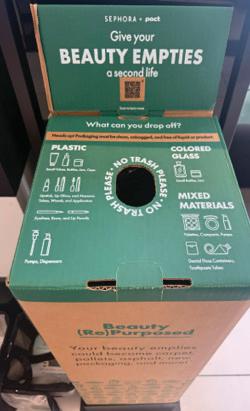
Sephora promotes sustainability by offering recycling and expanding its selection of ecofriendly beauty products.
In addition, hashtags such as #crueltyfreemakeup grow in views every day, creating a lasting impact in the beauty industry.
Even professionals are noticing this apparent shift. “We have more and more clients looking for more on the cleaner side of makeup,” said Naz, a Sephora employee. “I see less brands converting their ingredients and rather new brands launching and starting off as cruelty-free. There are a lot of new brands coming in that are cruelty-free. For example, Haus Labs and ILIA are the new and popular ones.”
Brian Tuel, a science teacher at Archbishop Riordan, said, “This social trend really all comes down to the science of the products as well. Many cruelty-free brands also remove harsh chemicals and irritants. It’s better for the animals but also better for your skin in the long run.”

With more awareness on the topic, more options available, and more demand for cruelty free products, there is no longer a question for many on whether you should be using cruelty free products. The message is loud and clear for young consumers in that you don’t need to hurt animals to look and feel good.
No matter what you see your role as in terms of make-up, it is worth checking out the labels and learning where your products really come from. The smallest shift in what you buy can help shape a more compassionate beauty industry. That change starts within the consumer, and within the people that make up the beauty industry.


Popular cruelty-free products like Too Faced draw attention for and praise from consumers because of the quality and compassionate values.
Scan this QR code to watch a full video story: “Makeup with a Mission,”
At Target, cruelty-free brands like e.l.f. and Milani are increasingly taking center stage as consumers demand more products that do not test on animals.
Scan this QR code to view a timeline that shows the key moments that shaped the crueltyfree movement in the beauty.
Photo by Daniella Lainez ’26
By Daniella Lainez ’26
Photo by Daniella Lainez ’26
Tetris plays preventative role in PTSD symptoms
By Angela Jia ’25
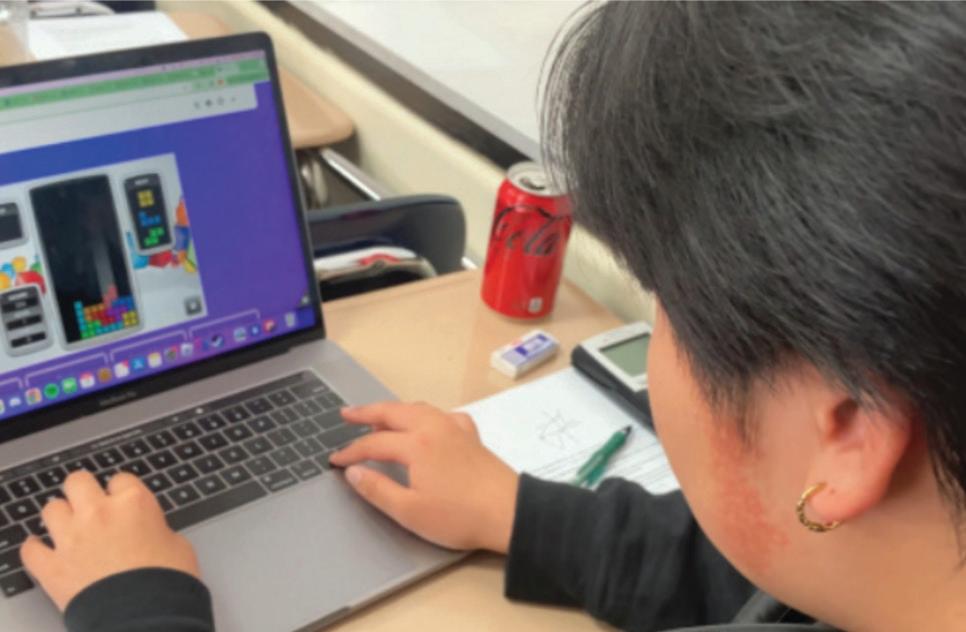
By Angela Jia ’25
On a particularly slow day in the library during his free block, Marco Romero ’25 innocuously slides out his phone from under his desk.
As students around him quietly chat, watch movies on their iPads or do homework, he opens a wellloved app that distracts him in a pinch during boring times like these: Tetris.
“I enjoy Tetris because it’s a simple game I can play whenever and mostly wherever I like,” Romero said. “Usually [it’s] to make time go faster and to decompress.”
However, one person’s Tetris is another patient’s treatment.
A 2017 study by Oxford researchers and colleagues at the Karolinska Institutet found that Tetris was an effective preventative in post traumatic stress (PTSD) symptoms for victims in motor vehicle accidents.
In their experiment, which was located in an emergency department receiving motor vehicle accident victims, a 20 minute “dose” of Tetris administered within six hours of the accident resulted in fewer intrusive memories that also diminished more quickly for the patients.
As hypothesized, it was more effective as compared to the control group that was tasked with a non-

Tetris placebo intervention.
The study is titled “Preventing intrusive memories after trauma via a brief intervention involving Tetris computer game play in the emergency department: a proofof-concept randomized controlled trial.”
The implications of this study are profound.

ability to function without fear in the world.
Such intrusive memories were something the study aimed to target.
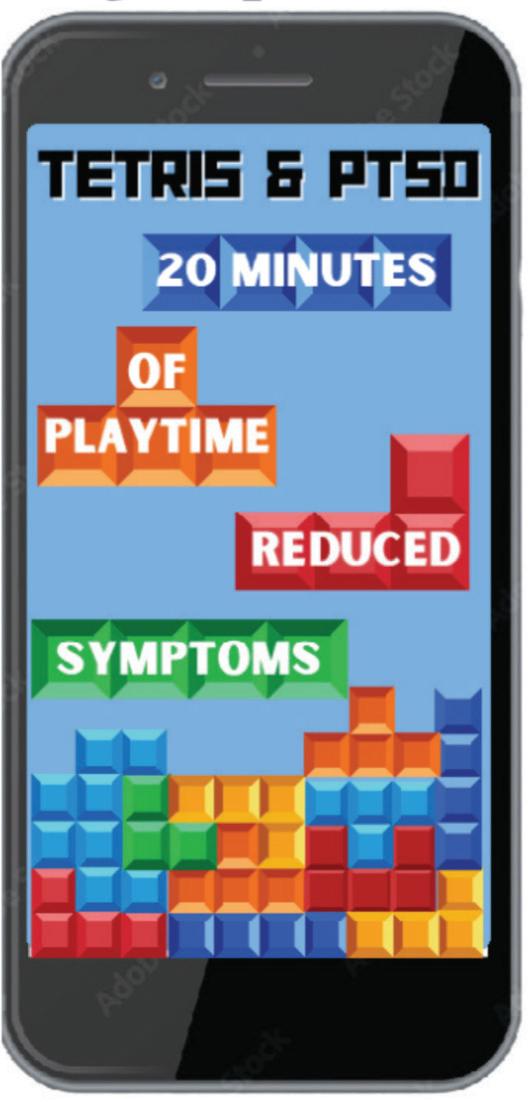
themselves from themselves and the trauma and just concentrate on the game.
Martinez continued, “Distraction has always been a tool I use when students are triggered or experiencing anxiety/ panic attacks.”
For patients, this study provides hope in a nonpill form.
-Vanessa Martinez, Class of ’25 Counselor “
Vanessa Martinez, Class of ’25 counselor with a Masters in School and College Counseling from SFSU, said, “For patients, this study provides hope in a nonpill form.
“For doctors and medical professionals, it’s proof that we need to continue researching unorthodox methods to help people with mental illness/ disorders.”
The mental illness PTSD occurs after a traumatic event–such as motor vehicle accidents, where one in four victims develop PTSD–and is characterized by reliving or having flashbacks of the event.
That can involve persistent intrusive memories of the trauma and significantly impair a person’s
When he plays the game, Romero said, “I feel relaxed, it’s satisfying watching myself clear the Tetris board.”
The distractory nature of the game–precisely what Romero enjoys about it–is key to its efficacy, according to Emily Holmes, professor of psychology at Karolinska Institutet’s Department of Clinical Neuroscience.
The visually demanding nature of the game, plus its mental engagement and sound effects, is what disrupts the traumatic memory from being ingrained into the mind in a process known as memory consolidation.
Romero intuitively echoes that expertise as he described what he would want in the aftermath of a potential trauma.
He said, “Definitely something to distract me, probably music, a task at hand not too brainstressing but just enough to occupy the mind.”
Additionally, Martinez thinks there’s a benefit in how Tetris doesn’t involve human characters.
The geometric blocks allow a victim-patient to fully detach
“I am always looking for new ways to help students control what they can when the brain can be so unpredictable.”
Beyond the novelty of Tetris, what also makes it unique in the wheelhouse of PTSD treatment is that it’s a preventative instead of a post-diagnosis treatment.
As the study states, “Preventive interventions post trauma are lacking… Participants found the intervention easy, helpful and minimally distressing…. we offer a promising new lowintensity psychiatric intervention that could prevent debilitating intrusive memories following trauma.”
Looking ahead, researchers are hoping to replicate the study on a larger scale over a one month period when a PTSD diagnosis can actually be given. This study just recorded results after a week.
Romero said, “I think it’s very interesting. I would’ve never thought that a game I enjoy to pass the time would help others out in such an impactful way.”

Vee Chen ’25 plays Tetris on a laptop during a break at school.
